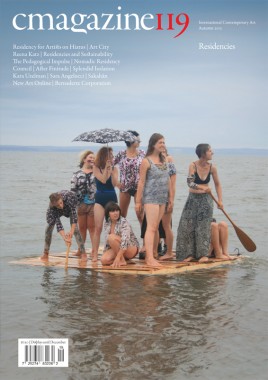
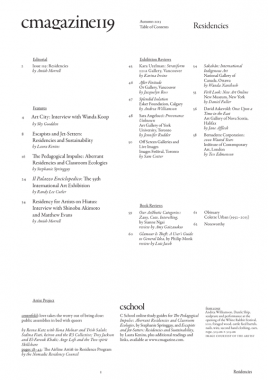
C Magazine 119, Residencies
Softcover, 64 pp., offset 4/1, 210 x 295 mm
Edition of 2200
ISSN 1480-5472
Published by C Magazine
$7.50 ·
Issue 119 includes feature essays by Laura Kenins on “Escapists and Jet-Setters: Residencies and Sustainability”, Stephanie Springgay on “The Pedagogical Impulse: Aberrant Residencies and Classroom Ecologies,” and Randy Lee Cutler on the 55th Venice Biennale, as well as Sky Goodden in conversation with Wanda Koop and an interview by Amish Morrell with Shinobu Akimoto and Matthew Evans. C119 also includes an artist project by the Nomadic Residency Council and the collaborative project “love takes the worry out of being close: public assemblies in bed with queers”; book reviews and reviews of exhibitions by Kara Uzelman, Sara Angelucci, David Askevold, Bernadette Corporation and more.
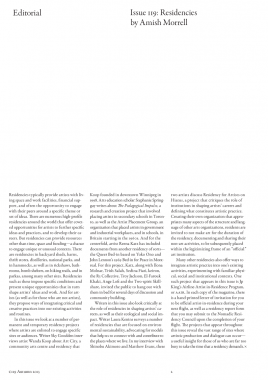
Amish Morrell, Art, Bernadette Corporation, C Magazine, Culture, David Askevold, Distribution, Fashion, Kara Uzelman, Laura Kenins, Matthew Evans, Randy Lee Cutler, Sara Angelucci, Shinobu Akimoto, Sky Goodden, Stephanie Springgay
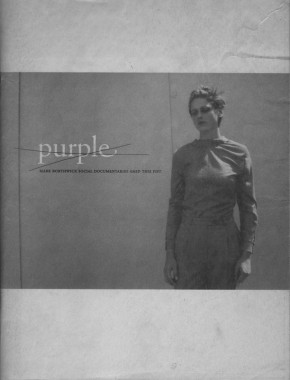
Mark Borthwick, Social documentaries amid this pist
Softcover, 240 pp., web offset 1/1, 210 x 270 mm
Edition of 250
Published by Mark Borthwick (2002)
$150.00 ·
condition:
good, minor edge wear, binding intact.
A social documentary. An appropriation of distinctions between elements. Grey area. An essay in images that repeat themselves. An apparent way to dilute the importance of one over another. Black and white photographs, hand written texts, and xeroxed pages.
Aaron Rose, Art, Bernadette Corporation, Bless, Brendan Fowler, Claude Closky, Culture, Desiree Heiss, Elein Fleiss, Ines Kaag, Made in USA, Maria Cornejo, Mark Borthwick, Nakako Hayashi, Olivier Zahm, Photography, Purple, Susan Cianciolo, Used
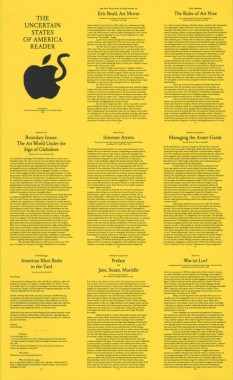
Noah Horowitz and Brian Sholis, The Uncertain States of America Reader
Softcover, 204 pp., offset 1/1, 155 x 255 mm
Edition of 2000
ISBN 978-1-933128-21-4
Published by Sternberg Press
$35.00 ·
What do artists read? What articles, books, reviews — and cartoons, cookbooks, memoirs and film scripts — influence their work? Here are some answers from the participating artists in the Uncertain States of America exhibition in Oslo and London in 2005. This book, a companion to the exhibition catalog, is an eclectic compilation of material that gives the reader a deeper insight into the influences that created the show. From Dora Apel’s Art Journal article on Torture Culture to Giorgio Agamben’s Le Monde piece on his refusal to visit the United States because he will not allow electronic archiving of his fingerprints, this is a thought-provoking reader for our times. Contributions by Julian Stallabrass, Johanna Burton, Isabelle Graw, Andrea Fraser, Pamela M. Lee, Miwon Kwon, Matthew Jesse Jackson, Jack Bankowsky, Chris Kraus, David Barringer, Bernadette Corporation, Seth Price, Kirk Varnedoe, Tim Griffin, Ralph Rugoff, Matt Wolf, Hamza Walker, Paul Chan, Giorgio Agamben, Critical Art Ensemble, Gregory Sholette, Alan Gilbert, Robert Morris, Iain Boal, T.J. Clark, Joseph Matthews, Michael Watts, Dora Apel, Kymberly N. Pinder, Molly Nesbit, Trisha Donnelly.
Andrea Fraser, Art, Bernadette Corporation, Chris Kraus, Critical Art Ensemble, David Barringer, Dora Apel, Giorgio Agamben, Gregory Sholette, Hamza Walker, Isabelle Graw, Jack Bankowsky, Johanna Burton, John Bowe, Julian Stallabrass, Kirk Varnedoe, Kymberly N. Pinder, Matt Wolf, Matthew Jesse Jackson, Miwon Kwon, Molly Nesbit, Paul Chan, Ralph Rugoff, RAM, Retort, Robert Morris, Seth Price, Sternberg Press, Tim Griffin, Trisha Donnelly
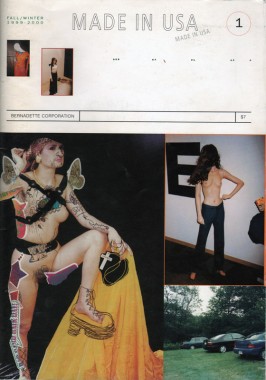
Bernadette Corporation, Made in USA
Softcover, 128 pp., offset 4/1, 7 x 10 inches
Edition of 500
Fall/Winter 1999-2000
Published by Bernadette Corporation
out of print
condition:
very good, shelf wear.
Bernadette Corporation: three people in New York City (today, 1999, or 2000) working together on a new fashion magazine called Made In USA and making art. We came from different backgrounds, but we had something in common: we wanted to change the world because we didn’t like the way it was.
The first issue of Made in USA is devoted to how people create their own spaces, spaces that can be invisible or imaginary. You may have heard this trend called DIY (do-it-yourself) or Amateurism. We like to call it the EMPTY WIDE SPACE trend, a place we can all disappear to, instead of being anti-everything and writing the new manifesto, or instead of being pro-everything and buying the latest CD.
Actress, Antek Walczak, Art, Bernadette Corporation, Bernadette Van-Huy, Culture, Desiree Heiss, Dike Blair, Fashion, Ines Kaag, Jeff Rian, Jim Fletcher, John Kelsey, Jonathan Horowitz, Made in USA, Mark Gonzales, Miltos Manetas, Patrick Li, Rita Ackermann, Rob Pruitt, Sadie Laska, Serge Daney, Susan Cianciolo, Used, Wandering Archive

Aleksandra Mir, Corporate Mentality
Softcover, 256 pp., offset 4/1, 230 x 300 mm
Edition of 2000
ISBN 0-9711193-1-7
Published by Sternberg Press
$40.00 · out of stock
Calling for a reassessment of the function of art in late capitalist society,
Corporate Mentality focuses on the complex and ambiguous ways artistic production inhabits corporate processes, abandoning the autonomy of the artwork in order to elaborate resistant approaches to a world increasingly determined by commercial strategies and market concerns.
Based on an archive (1995–2001) maintained by Aleksandra Mir, it presents a diverse spectrum of artists who take on business as site, as material, and as subject of their work. As Will Bradley writes in frieze, “The book focuses on … an essential area of interest as artists wake up to the reality of the Clinton-era fantasy of ethical corporatism. The plan came out of Mir and Kelsey’s realization that the publicity industry wasn’t stealing artists’ ideas, but simply employing artists, like Mir herself, who needed a day job. ‘Radical’ aesthetics that had taken at least six months to travel (we’re in New York here) from downtown to uptown were now transferred almost instantaneously, causing artists to reassess their methods.”
Absolute Vodka, Anthony Davies, Art, Atelier van Lieshout, Bennett Simpson, Bernadette Corporation, Carey Young, Claude Closky, Daniel Pflumm, Dejanov & Heger, Gareth James, John Kelsey, Lars Bang Larsen, Laura K. Jones, Liam Gillick, Matthieu Laurette, Piotr Uklanski, Purple Institute, RAM, Simon Ford, Sternberg Press, Superflex, Will Bradley

Bernadette Corporation, Eine Pinot Grigio, Bitte
Softcover, 150 pp., offset 4/1, 165 x 240 mm
Edition of 2000
ISBN: 978-1-933128-17-7
Published by Sternberg Press
$25.00 · out of stock
Formed in 1994, the Bernadette Corporation is a creative collective based in New York and Europe and organized around revolving memberships and associations. Its artistic output has ranged from fashion to film and literature, training videos, photography, etc., consistently insisting on the idea that the re-imagined format should inform the subject and give shape to its output. Whereas the first book released by BC was reportedly written by 150 people, in an “exquisite corpse” format, the second “novel,” entitled Be Corpse, is described as “a screenplay that cannot be a film” or “a film that can only be on paper.” A drama in three acts, the text seeks to make the gap between our primordial and contemporary selves collapse on itself, revealing an instinctless body and the brain manifest as the over-stimulated observer. Above all, Be Corpse should be received as the continuation of BC’s indirect, fiercely independent critique of our late capitalist/globalized world.
Art, Bernadette Corporation, Book Works, Fashion, Film, RAM, Sternberg Press







